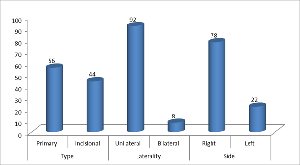To Evaluate the Safety and Efficacy of the ETEP Technique in Treating Inguinal Hernias
Authors
##plugins.themes.bootstrap3.article.main##
Abstract
Background: Inguinal hernia (IH) refers to the abdominal void protrusion via the inguinal canal. Tension-free hernioplasty (OTFH) is the standard procedure for effective treatment. Laparoscopic totally extraperitoneal prosthesis (TEP) is a novel procedure obviates the need for the opening of the patient's abdominal cavity and allows for a direct operation on the patient's anterior peritoneal space with benefits less pain, faster recovery, and a lower risk of complications. Methods: Prospective study conducted at Department of General Surgery, Government Medical College, to evaluate the safety and efficacy of the ETEP technique in treating inguinal hernias from 1stAugust 2023-31stJuly2024 with sample size of 50 subjects. Results: Primary and incisional hernia was revealed in 56% and 44% of the subjects respectively. Most of the subjects had unilateral hernia (92%). Mean operative time was 121.48±18.97minutes. Mean VAS was 4.8 after 12 hrs of surgery. Mean hospital stay after surgery was 1.2±0.4days. Mean duration to return back to work after surgery was 9.5days. No complication was reported among the study subjects. Conclusion: e-TEP technique is striking among all surgical approaches for laparoscopic hernia repair. eTEP approach gives a wide area to negotiate around and conclude the procedure, thus taking out the shortcomings of TEP/TAPP in inguinal hernias.
##plugins.themes.bootstrap3.article.details##
Copyright (c) 2025 Ayushi Bhushan, Mohit Kumar, Abhimanyu Singh Manhas, Gurbir Singh

This work is licensed under a Creative Commons Attribution 4.0 International License.
Creative Commons License All articles published in Annals of Medicine and Medical Sciences are licensed under a Creative Commons Attribution 4.0 International License.
Ayushi Bhushan, Senior Resident, Department of General Surgery, Government Medical College, Jammu and Kashmir, India.
Senior Resident, Department of General Surgery, Government Medical College, Jammu and Kashmir, India.
Mohit Kumar, Senior Resident, Department of General Surgery, Government Medical College, Jammu and Kashmir, India.
Senior Resident, Department of General Surgery, Government Medical College, Jammu and Kashmir, India.
Abhimanyu Singh Manhas, Senior Resident, Department of General Surgery, Government Medical College, Jammu and Kashmir, India.
Senior Resident, Department of General Surgery, Government Medical College, Jammu and Kashmir, India.
Gurbir Singh, Assistant Professor, Department of General Surgery, SMVDIME Kakryal, Jammu and Kashmir, India.
Assistant Professor, Department of General Surgery, SMVDIME Kakryal, Jammu and Kashmir, India.
[1] Shakil A, Aparicio K, Barta E, et al. Inguinal hernias: diagnosis and management. American family physician. 2020;102(8):487-92.
[2] Primatesta P, Goldacre MJ. Inguinal hernia repair: incidence of elective and emergency surgery, readmission and mortality. International journal of epidemiology. 1996;25(4):835-9.
[3] Kingsnorth AN, Bowley DM, Porter C. A prospective study of 1000 hernias: results of the Plymouth Hernia Service. Annals of the Royal College of Surgeons of England. 2003;85(1):18.
[4] Dalenbäck J, Hjortborg M, Rimbäck G. Inguinal hernia in adults. Läkartidningen. 2016;113.
[5] Current issues, problems and prospects of tension-free hernioplasty (review). Georgian Medical News. 2014;232-233:7–12.
[6] Tunio NA. Hernioplasty: Tension free mesh repair versus Mayos repair for umbilical hernias. JPMA. The Journal of the Pakistan Medical Association. 2017;67(1):24-6.
[7] Rege SA, Churiwala JJ, Kaderi AS, et al. Comparison of efficacy and safety of the enhanced-view totally extraperitoneal (eTEP) and transabdominal (TARM) minimal access techniques for retromuscular placement of prosthesis in the treatment of irreducible midline ventral hernia. Journal of Minimal Access Surgery. 2021;17(4):519-24.
[8] Li JW, Yue F. Application of membrane anatomy theory in totally extraperitoneal inguinal hernia repair. Zhonghuawei Chang waike za zhi= Chinese Journal of Gastrointestinal Surgery. 2021;24(7):604-10.
[9] Fernandez SS, Vilarrasa MF, Silla IO, et al. Extended totally extraperitoneal (eTEP) approach for ventral hernia repair: initial results. Cirugía Española (English Edition). 2020;98(5):260-6.
[10] Singh S, Kala S, Jauhari RK, et al. A prospective randomized study of eTEP and TEP repair for inguinal hernia in terms of ease of operability, complication and recurrences. Asian Journal of Medical Sciences. 2022;13(3):87-94.
[11] Köckerling F, Bittner R, Kuthe A, et al. TEP or TAPP for recurrent inguinal hernia repair-register-based comparison of the outcome. SurgEndosc. 2017;31(10):3872-3882.
[12] Penchev D, Kotashev G, Mutafchiyski V. Endoscopic enhanced-view totally extraperitoneal retromuscular approach for ventral hernia repair. Surgical endoscopy. 2019;33:3749-56.
[13] Baig SJ, Priya P. Extended totally extraperitoneal repair (eTEP) for ventral hernias: Short-term results from a single centre. Journal of minimal access surgery. 2019;15(3):198-203.
[14] Novitsky YW, Elliott HL, Orenstein SB et al. Transversus abdominis muscle release: A novel approach to posterior component separation during complex abdominal wall reconstruction. Am J Surg. 2012;204(5):709-16.
[15] Binnebösel M, Klink CD, Otto J, et al. Impact of mesh positioning on foreign body reaction and collagenous ingrowth in a rabbit model of open incisional hernia repair. Hernia. 2010;14:71-7.
[16] Karim T, Katiyar VK, Jain A, et al. Comparison of trans-abdominal preperitoneal repair with Lichtenstein tension-free hernioplasty: A prospective study. Formos J Surg. 2021;54:19-24.
[17] Kumar N, Palanisamy NV, Parthasarathi R, et al. A comparative prospective study of short-term outcomes of extended view totally extraperitoneal (e-TEP) repair versus laparoscopic intraperitoneal on lay mesh (IPOM) plus repair for ventral hernia. Surgical Endoscopy. 2021;35:5072-7.
[18] Joshi J and Dekhaiya F. A Comparative study between E-TEP versus IPOM hernia repair. IOSR J Dent Med Sci. 2020;19(3):19-21.
[19] Vinay G and Balasubrahmanya KS. Comparative study on laparoscopic transabdominal pre-peritoneal (TAPP) mesh repair and total extra-peritoneal (TEP) repair in inguinal hernia. Madridge J Surg. 2018;1(1):9-13.
[20] Sharma D, Yadav K, Hazrah P, et al. Prospective Randomized trial comparing laparoscopic transabdominal preperitoneal (TAPP) and laparoscopic totally extra peritoneal (TEP) approach for bilateral inguinal hernias. Int J Surg 2015;22:110-7.
[21] Hallen M, Bergenfelz A and Westerdahl J. Laparoscopic extraperitoneal inguinal hernia repair versus open mesh repair: Long-term follow-up of a randomized controlled trial. Surgery. 2008;143(3):313-7.
[22] Rekhi HS, Singh G, Sharma E et al. Assessment of perioperative outcome in primary unilateral inguinal hernia: A comparative study. Int J Surg Sci. 2020;4(2):229-32.
[23] Reza SM, Hoque MM, Akther SM, et al. Early outcomes of extended view total extraperitonial (eTEP) procedure for inguinal hernia. J Shaheed Suhrawardy Med Coll. 2019;11(2):96-100.

